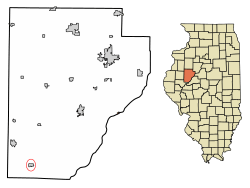Liverpool, Illinois
Liverpool is a village in Fulton County, Illinois, United States. The population was 129 at the 2010 census.[3]
Liverpool, Illinois | |
|---|---|
Village | |
 Location of Liverpool in Fulton County, Illinois. | |
.svg.png) Location of Illinois in the United States | |
| Coordinates: 40°23′27″N 90°0′3″W | |
| Country | United States |
| State | Illinois |
| County | Fulton |
| Township | Liverpool |
| Area | |
| • Total | 0.09 sq mi (0.22 km2) |
| • Land | 0.08 sq mi (0.22 km2) |
| • Water | 0.00 sq mi (0.00 km2) |
| Elevation | 445 ft (136 m) |
| Population (2010) | |
| • Total | 129 |
| • Estimate (2019)[2] | 123 |
| • Density | 1,464.29/sq mi (564.36/km2) |
| Time zone | UTC-6 (CST) |
| • Summer (DST) | UTC-5 (CDT) |
| ZIP Code(s) | 61542 |
| Area code(s) | 309 |
| FIPS code | 17-44121 |
| Wikimedia Commons | Liverpool, Illinois |
The mayor of Liverpool is Rebecca "Becky" Humphery.
Maxine Raker Mytar wrote The River and Beyond and Once Again Lightly about her childhood growing up in Liverpool and her later life in California.
History
Liverpool was first settled in 1826. Multiple mills were established in the 1830s. In 1850 a plank road was established between Liverpool and Canton, Illinois.[4]
Geography
Liverpool is located in eastern Fulton County at 40°23′27″N 90°0′3″W (40.390763, -90.000877),[5] on the north bank of the Illinois River at river mile 128. It is 10 miles (16 km) east of Lewistown, the Fulton County seat, and 34 miles (55 km) southwest of Peoria.
According to the 2010 census, Liverpool has a total area of 0.081 square miles (0.21 km2), of which 0.08 square miles (0.21 km2) (or 98.77%) is land and 0.001 square miles (0.00 km2) (or 1.23%) is water.[6]
Demographics
| Historical population | |||
|---|---|---|---|
| Census | Pop. | %± | |
| 1880 | 129 | — | |
| 1960 | 184 | — | |
| 1970 | 218 | 18.5% | |
| 1980 | 243 | 11.5% | |
| 1990 | 129 | −46.9% | |
| 2000 | 119 | −7.8% | |
| 2010 | 129 | 8.4% | |
| Est. 2019 | 123 | [2] | −4.7% |
| U.S. Decennial Census[7] | |||
At the 2000 census,[8] there were 119 people, 47 households and 32 families residing in the village. The population density was 1,475.7 per square mile (574.3/km2). There were 69 housing units at an average density of 855.7 per square mile (333.0/km2). The racial makeup of the village was 99.16% White, and 0.84% from two or more races. Hispanic or Latino of any race were 0.84% of the population.
There were 47 households, of which 34.0% had children under the age of 18 living with them, 55.3% were married couples living together, 6.4% had a female householder with no husband present and 31.9% were non-families. 29.8% of all households were made up of individuals and 6.4% had someone living alone who was 65 years of age or older. The average household size was 2.53 and the average family size was 3.16.
The age distribution of the population was 28.6% under the age of 18, 6.7% from 18 to 24, 26.1% from 25 to 44, 24.4% from 45 to 64, and 14.3% who were 65 years of age or older. The median age was 38. For every 100 females, there were 108.8 males. For every 100 females age 18 and over, there were 117.9 males.
The median household income was $33,333 and the median family income was $36,250. Males had a median income of $24,375 versus $18,750 for females. The per capita income for the village was $11,848.
References
- "2019 U.S. Gazetteer Files". United States Census Bureau. Retrieved July 14, 2020.
- "Population and Housing Unit Estimates". United States Census Bureau. May 24, 2020. Retrieved May 27, 2020.
- "Geographic Identifiers: 2010 Census Summary File 1 (G001), Liverpool village, Illinois". American FactFinder. U.S. Census Bureau. Archived from the original on February 13, 2020. Retrieved May 17, 2016.
- a history of Liverpool, Illinois
- "US Gazetteer files: 2010, 2000, and 1990". United States Census Bureau. 2011-02-12. Retrieved 2011-04-23.
- "G001 - Geographic Identifiers - 2010 Census Summary File 1". United States Census Bureau. Archived from the original on 2020-02-13. Retrieved 2015-08-04.
- "Census of Population and Housing". Census.gov. Retrieved June 4, 2015.
- "U.S. Census website". United States Census Bureau. Retrieved 2008-01-31.